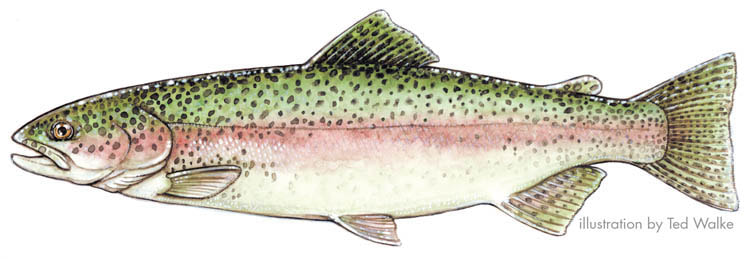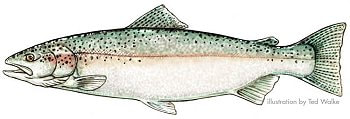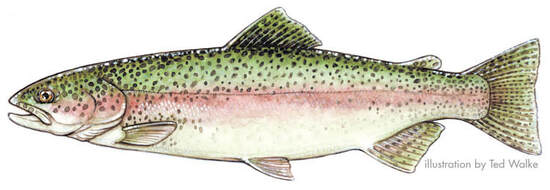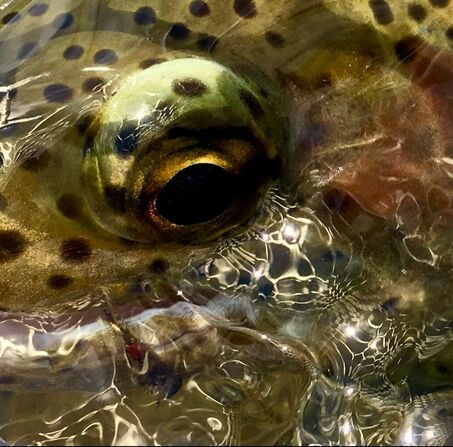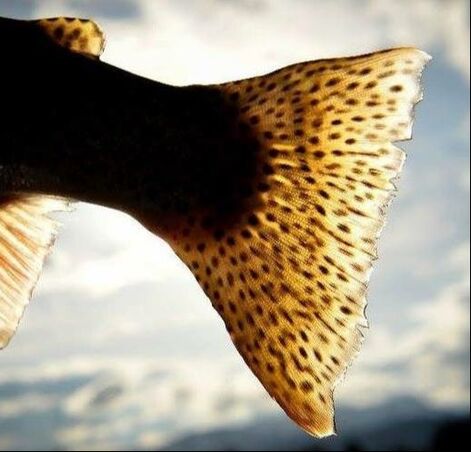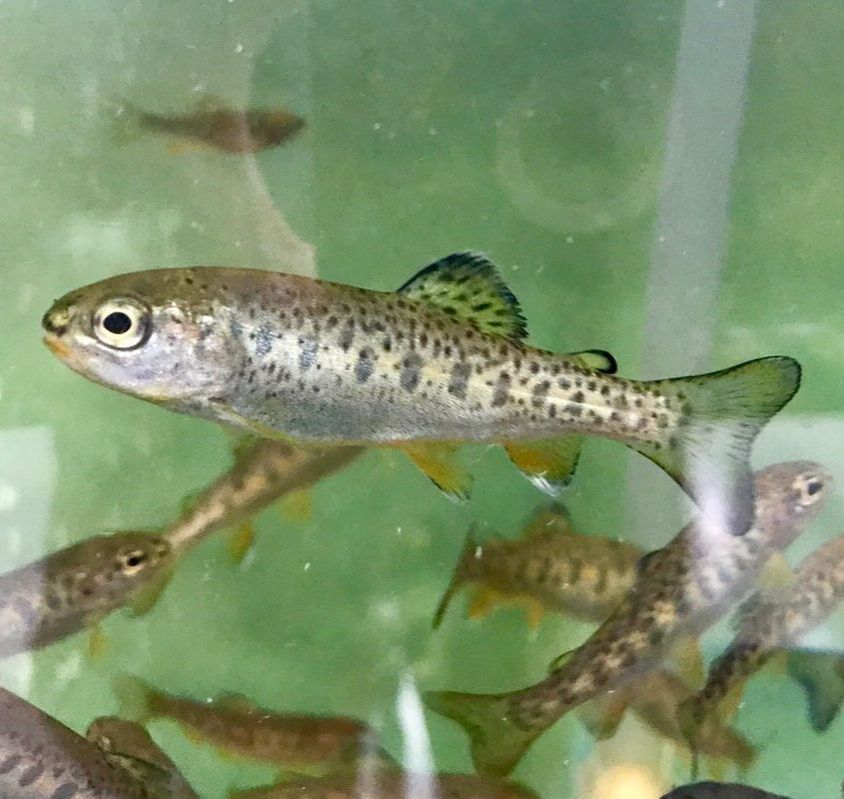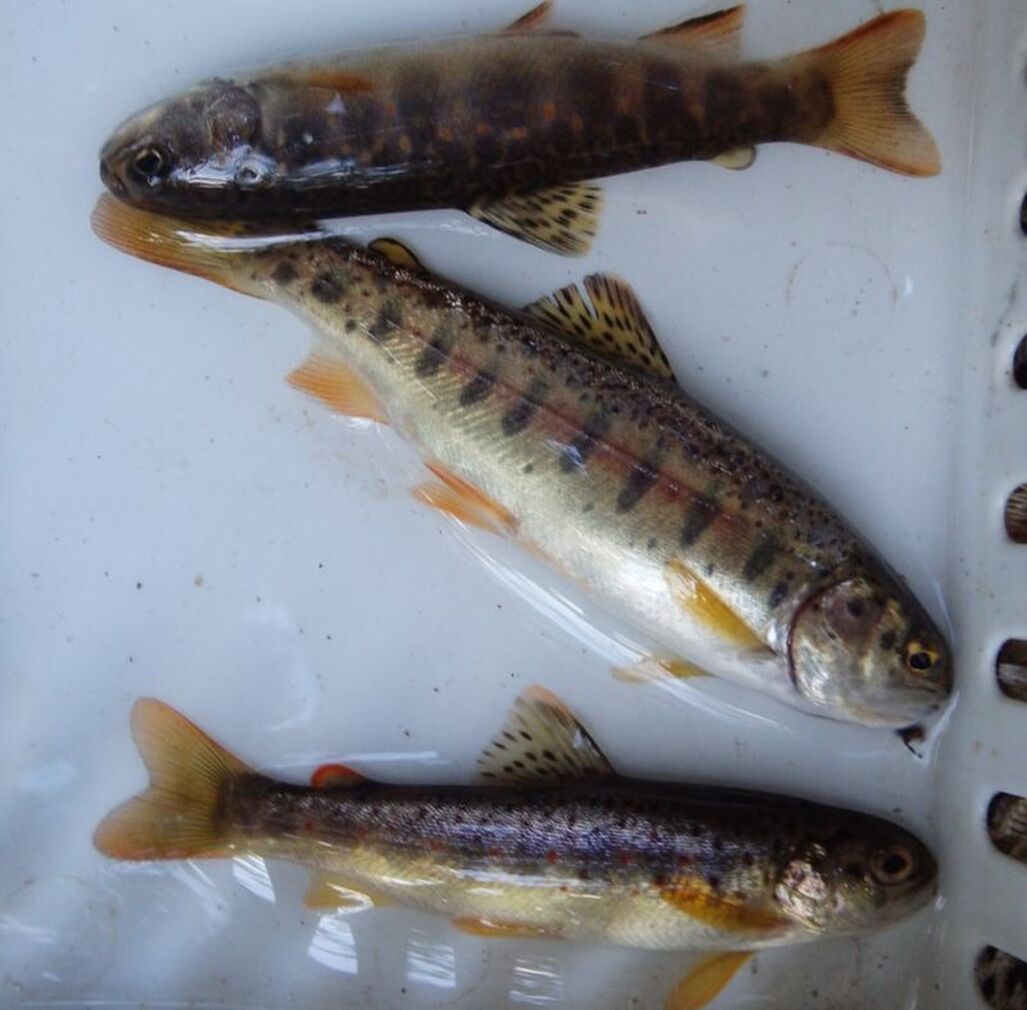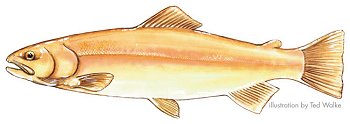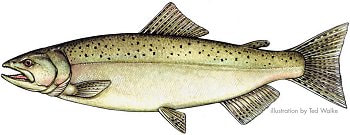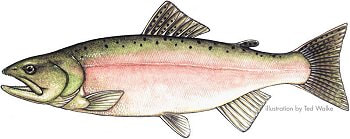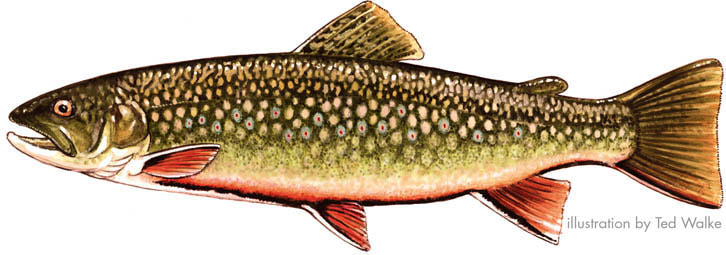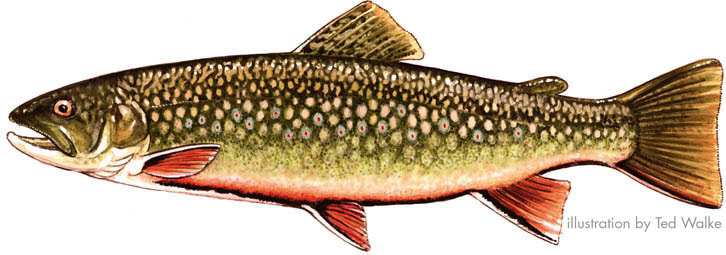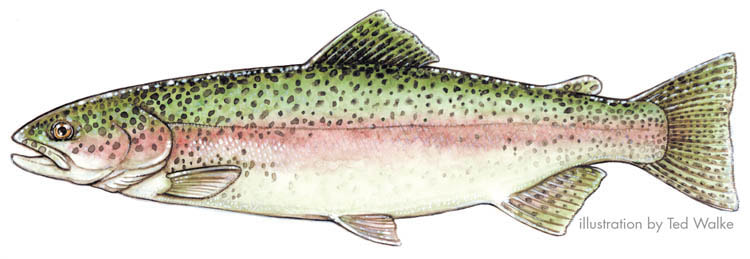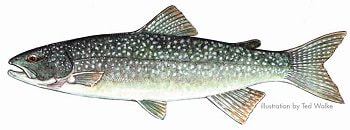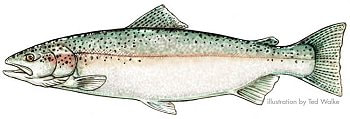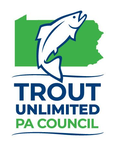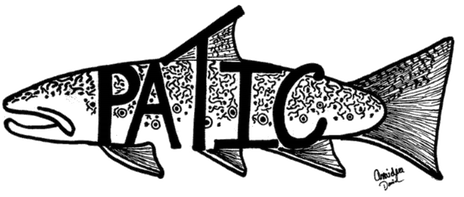Species Overview
|
Rainbow Trout (Oncorhynchus mykiss) are a western North American species, native to the Pacific slope from California to Alaska, and non-native to Pennsylvania streams. In a turn-of-the-century effort to restore Pennsylvania’s degraded trout fishery, Rainbows were introduced throughout the state.
|
But today, as wild fish, Rainbows sustain reproducing populations only in a handful of fast-falling creeks scattered around the state. As stocked, hatchery-reared fish, Rainbows are found throughout Pennsylvania’s watersheds.
For many years, the Rainbow was considered a near relative of the Brown Trout, and it was given the scientific name Salmo gairdneri, which still appears in some reference books. Today, biologists consider the Rainbow more closely akin to the Pacific Salmons and the Cutthroat Trout of the West. Its scientific name was changed to reflect that link. Like those salmons, some Rainbows (steelhead) run to the ocean or a large sealike lake, like the Great Lakes, if they have access, returning upstream for spawning. Then they are called “steelhead” (they appear steel-colored, or more silvery, than stream rainbows). Rainbows are flashy fighters when hooked, jumping out of the water more than other trout. The genus name “Oncorhynchus” means “hooked snout,” referring to the hooked lower jaw of big, breeding males.
For many years, the Rainbow was considered a near relative of the Brown Trout, and it was given the scientific name Salmo gairdneri, which still appears in some reference books. Today, biologists consider the Rainbow more closely akin to the Pacific Salmons and the Cutthroat Trout of the West. Its scientific name was changed to reflect that link. Like those salmons, some Rainbows (steelhead) run to the ocean or a large sealike lake, like the Great Lakes, if they have access, returning upstream for spawning. Then they are called “steelhead” (they appear steel-colored, or more silvery, than stream rainbows). Rainbows are flashy fighters when hooked, jumping out of the water more than other trout. The genus name “Oncorhynchus” means “hooked snout,” referring to the hooked lower jaw of big, breeding males.
IdentificationRainbow Trout are silvery-gray to dark-green on the back and sides. They have a pinkish or reddish lateral stripe, sometimes with lavendar or orange overtones, from the gill cover running the length of the fish to the tail. The caudal fin has rows of small dark spots, and there are more small blackish spots sprinkled on the head and sides, and spotting on the dorsal and adipose fins. The belly is whitish. The lower fins are pale-pink without spots.
At spawning time, males become deeply colored with an intensely red side stripe. Steelhead can be separated from similar-looking Coho and Chinook Salmon by looking at the inside of the mouth. The mouth is completely white in the steelhead. In the salmons, the mouth has some gray or black. Steelhead and other deepwater, big lake Rainbows are more silvery than stream fish, with less of a side stripe. Great Lakes steelhead can grow to 30 inches and larger. The Pennsylvania state record for a Rainbow Trout is more than 20 pounds. |
Habitat
Rainbows are considered fastwater fish, preferring the swift runs and riffle areas of streams. They may live in small creeks, as well as suitable spots in large rivers, the tailwaters of dams, and in lakes and reservoirs. As trout, Rainbows live in cold, clean, well-oxygenated water. Their optimum water temperature is about 55 degrees. Although they do best when the water is under 70 degrees, they can withstand temperatures into the 70s if there is plenty of oxygen and a cool, shady place to which they can retreat. Rainbows are the trout least tolerant of acidity. They do best in slightly alkaline waters. As steelhead, Rainbows inhabit the cool waters of large lakes, especially Lake Erie and other Great Lakes, as well as oceans. Rainbow Trout respond well to hatchery culture and have been introduced for sport fishing throughout the world. In some places, especially the mountains of the southeastern United States, introduced Rainbows have encroached on native Brook Trout populations.
|
|
Life HistoryRainbow Trout are considered spring spawners, but steelhead may enter streams to spawn from late fall through spring. Spawning takes place when the water temperature is about 50 degrees, over gravel beds with good water flow. Rainbow Trout move upstream to find the proper spawning area. Rainbows in lakes seek tributary streams. Like other trout, the female Rainbow prepares the nest depression by turning on her side and “kicking” against the bottom gravel with her body and fins. Male Rainbows are aggressive on the spawning grounds, driving other males away from the female’s nest. When the actual spawning takes place, several males may be beside the female. The females produce several hundred to over 12,000 eggs, depending on their size. After the eggs are deposited into the gravel and fertilized, no parental care is given. The eggs hatch in four to seven weeks. The fry take up to another week in the gravel to absorb the yolk sac. Then they become free-swimming. Most Rainbows are sexually mature when they reach about three to five years old.
Documentation of successful natural reproduction in Pennsylvania is rare. Self-sustaining populations of Rainbow Trout are found only in a few scattered streams. But mature Rainbows, especially steelhead that have run up Lake Erie tributaries, successfully spawn and produce young. However, adult returns are mostly comprised of hatchery-released fish. Unlike salmon, which die after spawning, steelhead can spawn again, returning to the ocean or large lake to grow even bigger before the next year’s spawning run. Steelhead also follow other spawning fish migrating upstream and prey on their eggs and young. Rainbows feed on aquatic and terrestrial insects, crayfish and other crustaceans. Rainbows also eat fish, as well as plankton, snails, leeches and fish eggs. They take a variety of anglers’ flies, lures and baits. Rainbows have been intensively cultured in fish hatcheries. Strains have been developed that are of various colors, are tolerant of warm water, grow rapidly, resist disease and spawn at times different from the rainbow’s natural spawning time. The lifespan of the steelhead in the Great Lakes is six to eight years. Small-stream Rainbows may live only to be three or four years old. |
All About Trout Resources
Explore the below educational resources from the Pennsylvania Fish and Boat Commission (PFBC). These resources, along with many others from environmental education providers across the state, can also be found under Curriculum Connections.
Aquatic Organisms (Trout and MORE!)
Watersheds
Recreational Fishing
- All About Trout PLAY Youth Newsletter
- Aquatic Critters Fact Sheets (e.g., Mayflies, Stoneflies, Caddisflies, and more!)
- Aquatic Field Study Permitting: Permit needed to collect macroinvertebrates in PA, even if you release them
- Brook Trout Life Cycle Poster
- Fish Habitat Improvement, featuring project maps, videos, PowerPoint presentations, and a booklet
- PLAY (Spring 2006) – Six Legs Underwater (Learn fun facts about insect family tree, how they eat and more!)
- PLAY (Spring 2013) Fish Scene Investigation (Learn how biologists study and manage fish populations in PA)
- Trout Identification
- Trouts and Salmons of PA
- Trout Water Classifications
Watersheds
- Pond and Stream Study Guide
- PLAY (Winter 2019) – Water Flows Through PA
- PLAY (Fall 2019) H20 On the Go
- PLAY (Spring 2018) Water, Water, Read All About it! (water temperature, pH, Alkalinity, Turbidity)
- PLAY (Winter 2013) Good Fishing, Needs Good Habitat (Recipe for a healthy stream, stream and lake habitat toolbox, help this stream activity)
- Wetlands and why do fish need them
- Timbering and Trout
Recreational Fishing

